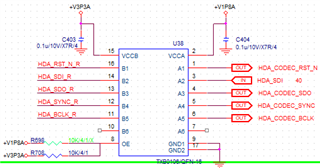Tool/software:
Designed for 1.8V to 3.3V
VccA=1.8V;VccB=3.3V
According to the specification OE pin needs to be Referenced to VCCA.
But in the experiment, if the IC uses 1.8V, it will not be able to output. It needs to use 3.3V to output.
This thread has been locked.
If you have a related question, please click the "Ask a related question" button in the top right corner. The newly created question will be automatically linked to this question.
Tool/software:
Designed for 1.8V to 3.3V
VccA=1.8V;VccB=3.3V
According to the specification OE pin needs to be Referenced to VCCA.
But in the experiment, if the IC uses 1.8V, it will not be able to output. It needs to use 3.3V to output.
Hello,
OE pin is over-voltage tolerant and can be biased to VCCA/ VCCB with no concerns (keep in mind the logic thresholds, VIH/VIL of the OE pin is still referenced to VCCA however). What is the status of VCCA/ VCCB during the time of test? Are there any waveforms/schematics that can be shared?
Regards,
Jack
Hi Jack

This design is used in Audio signals
If the OE pin uses 1.8V, I can't see the ALC888 in Windows 10 but there is a signal at the output, so I try to use 3.3V to control the OE pin and it works normally.
The waveform is the same whether using 3.3V or 1.8V output.
Regards,
Corn Chen
Hi Corn,
I do not see anything unusual in the schematic provided though I am afraid I do understand your statement completely. What are the voltages that the I/Os at A-side and B-side are being referenced to? Any waveforms that can be provided to show the an expected waveform vs. waveform with anomaly?
Regards,
Jack
Hi Corn,
The RST signals appear to be level shifting as expected, in both cases with OE=1.8V or 3.3V. Can you check if SDI/ SDIO signals are indeed intended signals for level translation meeting section 6.6-6.10 of datasheet (minimum requirement for pulse width duration) and not crosstalk?
Regards,
Jack
Hi Jack
There will be no problem using OE pin with 3.3V. It will only appear when using 1.8V.
Will changing the OE pin voltage affect the bandwidth?
In addition, it was found that the signal output would disappear during measurement. Please refer to file.
TXB0106 Signal measurement.docx
Regards,
Corn Chen
Hi Corn,
No, the OE pin voltage is over-voltage tolerant and will not impact supported bandwidth of device. You may need to zoom in further to see the individual data bits as it is hard to interpret the data currently.
Can you check if SDI/ SDIO signals are indeed intended signals for level translation meeting section 6.6-6.10 of datasheet (minimum requirement for pulse width duration) and not crosstalk
Were we able to check on the following?
Regards.
Jack
Hi Jack
The Audio signal frequency is 24Mbps and meets SPEC requirements.
I think the design complies with SPEC because it will be normal if the OE pin is replaced with 3.3V.
I'm measuring and trying to find any differences.
Regards,
Corn Chen
Hi Corn,
This is unusual as I would expect the 24Mbps signal to propagate through our device regardless of OE if connected to VCCA/ VCCB. Please make sure the OE ramp conditions are similar for both cases when connected to 1.8V/ 3.3V.
Is OE constantly being toggled or it is a continuous DC state? Please show OE state at the time of testing (and zoomed in waveforms to see the edges more clearly).
Regards,
Jack
Hi Jack
When the OE pin uses 1.8V according to SPEC, the "Audio function" will not be available, but it can be used normally when the OE pin uses 3.3V.
When OE uses 3.3V or 1.8V output, the waveforms are the same and there is no difference.
I can't find a difference in measurements.
Regards,
Corn Chen
Hi Corn,
There are no concerns from my side with which voltage OE pin is being biased to. A-side ports track VCCA voltage while B-side ports track VCCB. The OE pin of this device is also overvoltage tolerant supporting up to 5.5V, so customer may bias OE up to 5.5V with no issues.
Here is an FAQ explains this further: https://e2e.ti.com/support/logic-group/logic/f/logic-forum/867350/faq-can-i-connect-the-oe-pin-to-vccb-supply-pin-instead-of-vcca-for-txs-txb-devices
Thanks,
Jack
Hi Jack
I know the OE pin has overvoltage tolerance and can be connected to the Vccb supply, but that doesn't explain why using 1.8V makes it impossible to use the Audio Function.
Because we can't find any difference between using 3.3V or 1.8V.
Regards,
Corn Chen